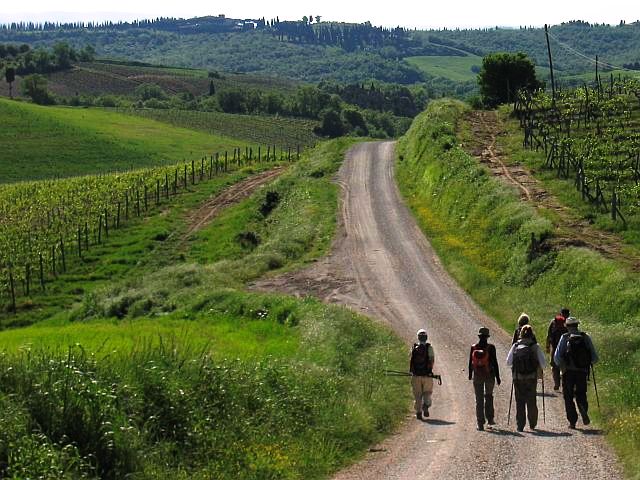Angela
Elite member
- Messages
- 21,823
- Reaction score
- 12,328
- Points
- 113
- Ethnic group
- Italian
Well, it's one of them. It's the ancient pilgrim route from France, hence the name, or more broadly, northern Europe, to Rome. It was analogous, I think, with the pilgrim route to Santiago de Compostela.
See:
https://en.wikipedia.org/wiki/Via_Francigena
"The name Via Francigena is first mentioned in the Actum Clusio, a parchment of 876 in the Abbey of San Salvatore al Monte Amiata (Tuscany).[2]At the end of the 10th century Sigeric the Serious, the Archbishop of Canterbury, used the Via Francigena to and from Rome in order to receive his pallium;[3] he recorded his route and his stops on the return journey,[4] but nothing in the document suggests that the route was then new.
Later itineraries to Rome include the Leiðarvísir og borgarskipan of the Icelandic traveller Nikolás Bergsson (in 1154) and the one from Philip Augustus of France (in 1191).[5] Two somewhat differing maps of the route appear in manuscripts of Matthew Paris, Historia Anglorum, from the 13th century."

I initially became interested in it because it passed quite literally in front of the house where I was born, and in later years I've walked parts of it myself. Unfortunately, stretches of it have been overlaid by modern roads, which is the case in the part that goes past my door, and no side paths have been provided, and parts of it aren't very well marked. Also, unlike the better known pilgrimage route to Santiago de Compostela, convenient accommodations don't exist everywhere, which means hikers have to camp out, but as it is getting more and more known, and more people are hiking it, I think it may change.
"Due to the scarcity of dedicated pilgrims' accommodation along the Via Francigena, pilgrims often camp out rather than staying in hotels or pensions, both options which would turn out expensive when used for weeks on end. However increasingly in Italy, some monasteries and religious houses offer dedicated pilgrim's accommodation. These are called spedali and — like the refugios found on the Way of St. James in France and Spain — they offer cheap and simple dormitory-style accommodation. Spedali accept pilgrims who bear a valid credenziale (pilgrim's passport), usually for one night only. Some places offer meals as well.
Way of St.James


Sigerico, Archbishop of Canterbury, stayed here, in Aulla, my municipal center, around 990 AD, and the Abbey and guest house are part of the very little of ancient Aulla which remains following the destruction during World War II.

People do it following guides, and there are also starting to be guided excursions.
http://www.viefrancigene.org/en/
See:
https://en.wikipedia.org/wiki/Via_Francigena
"The name Via Francigena is first mentioned in the Actum Clusio, a parchment of 876 in the Abbey of San Salvatore al Monte Amiata (Tuscany).[2]At the end of the 10th century Sigeric the Serious, the Archbishop of Canterbury, used the Via Francigena to and from Rome in order to receive his pallium;[3] he recorded his route and his stops on the return journey,[4] but nothing in the document suggests that the route was then new.
Later itineraries to Rome include the Leiðarvísir og borgarskipan of the Icelandic traveller Nikolás Bergsson (in 1154) and the one from Philip Augustus of France (in 1191).[5] Two somewhat differing maps of the route appear in manuscripts of Matthew Paris, Historia Anglorum, from the 13th century."

I initially became interested in it because it passed quite literally in front of the house where I was born, and in later years I've walked parts of it myself. Unfortunately, stretches of it have been overlaid by modern roads, which is the case in the part that goes past my door, and no side paths have been provided, and parts of it aren't very well marked. Also, unlike the better known pilgrimage route to Santiago de Compostela, convenient accommodations don't exist everywhere, which means hikers have to camp out, but as it is getting more and more known, and more people are hiking it, I think it may change.
"Due to the scarcity of dedicated pilgrims' accommodation along the Via Francigena, pilgrims often camp out rather than staying in hotels or pensions, both options which would turn out expensive when used for weeks on end. However increasingly in Italy, some monasteries and religious houses offer dedicated pilgrim's accommodation. These are called spedali and — like the refugios found on the Way of St. James in France and Spain — they offer cheap and simple dormitory-style accommodation. Spedali accept pilgrims who bear a valid credenziale (pilgrim's passport), usually for one night only. Some places offer meals as well.
Only a few decades ago, interest in the Via Francigena was limited to scholars. This began to change in recent years when many who, after travelling the
Way of St.James
in Spain, wanted to make the pilgrimage to Rome on foot as well. In Italy, this gave birth to a network of lovers of the Via Francigena, who with paint and brush, began to mark its trails and paths. These people were joined by religious and local government agencies who also tried to recover the original route. Where possible today's route follows the ancient one but sometimes it deviates from the historical path in favour of paths and roads with low traffic."


Sigerico, Archbishop of Canterbury, stayed here, in Aulla, my municipal center, around 990 AD, and the Abbey and guest house are part of the very little of ancient Aulla which remains following the destruction during World War II.
People do it following guides, and there are also starting to be guided excursions.
http://www.viefrancigene.org/en/

